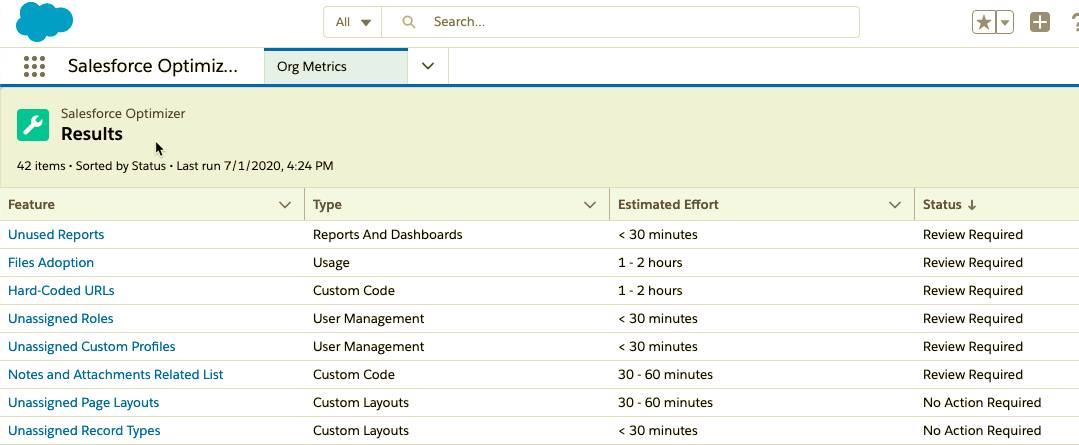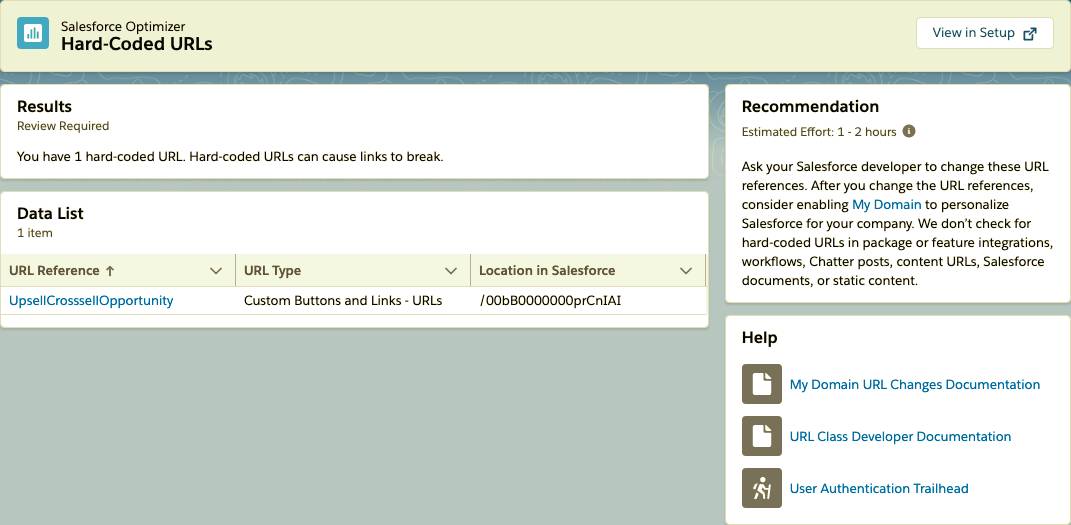Run a Scan and Review the Findings
Learning Objectives
After completing this unit, you’ll be able to:
- Generate a Salesforce Optimizer scan.
- List some issues and best practices that users commonly find in a Salesforce Optimizer report.
Availability of Salesforce Optimizer
In the previous unit, you learned about Salesforce Optimizer and why we created it. Hopefully you’re excited to try it out now. Before you do, let’s walk through a few basic system and user requirements.
Salesforce Optimizer is a Lightning Experience app available in Professional, Enterprise, Performance, Unlimited, and Developer Editions. You can run Optimizer in production and sandbox environments.
In this module, we assume you are a Salesforce admin with the proper permissions to run the Salesforce Optimizer. If you’re not an admin, that’s OK. Read along to learn how your admin would take the steps in a production org.
Run Salesforce Optimizer
Running Salesforce Optimizer is incredibly easy. Here’s how.
- From Setup, enter
Optimizerin the Quick Find box, then select Optimizer. - Click Allow Access to authorize Optimizer to analyze your org. Check the attestation checkbox, and click Save and Close.
- Click Open Optimizer. This launches the app in your org. Optimizer is now just like any other app in your org and can be accessed from the main App Launcher (
 ).
). - Click Run Optimizer.
That’s it! Salesforce typically finishes the scan within an hour, but it can take longer if your org is complex. Just head back to the Optimizer app to check progress (or refresh your browser if the page is still open).
Now What?
Running Optimizer is the easy part. Once the scan is finished, you’ll see a list of findings like this, sorted by status.

Now it’s time to review the findings and create a plan to address the issues found. The most urgent items are at the top of the list and have a status of Review Required. When you click any row in the table, Optimizer shows specific results from the scan, as well as recommended actions and links to relevant resources to assist you. There’s a button that takes you right to the relevant area in Setup so you can begin your investigation.

Let’s look at some of the most common and critical issues that Optimizer flags for customers.
Behold, Fields of Fields
It’s very common to see objects with hundreds of fields. While Salesforce allows up to 800 fields per object (depending on your edition), Salesforce Optimizer flags any standard or custom object with more than 350 fields. Are all those fields necessary and useful to your users? Look in your results list for the Field Usage row. It’s annoying to churn and scroll through hundreds of fields on a detail page. Adoption and usage suffers. And consider the mobile experience: scrolling through pages of fields on your phone is painful and frustrating.
Look at the Data List section in Field Usage to see whether those fields are populated with data. Many customers are surprised to find that a significant number of their custom fields are empty, and therefore provide no value to users.
If Optimizer flags your org for custom field limits, field usage, or fields on page layouts you are not alone. Cleanup in those areas is always appreciated by users.
Automation Overload
Everyone loves automation. Sharing, flows, and validation rules make users more efficient and keeps data tidy. But you can have too much of a good thing. For you admins out there, maintaining a Byzantine set of rules can be challenging. When there is too much automation on a single object, end users can experience slow performance and other issues. If your Salesforce Optimizer flags any of these categories, consider taking steps to simplify.
Too Many Admins
Salesforce Optimizer considers any user with the Modify All Data and Customize Application permissions an admin. Granting these superuser permissions to lots of users is a recipe for disaster. We know how it can happen: Sales Ops needs access to all Opportunities, so you add Modify All Data to their profile. Then a power user wants to modify picklist values on the Case object, so you grant them Customize Application access, and so on. But liberally doling out these kinds of permissions is risky and should be avoided. Data breaches, data quality, gacks — there are all sorts of unintended consequences when you have too many cooks in the kitchen.
So what’s the right number of admins? It really depends on the size of your organization, its complexity, and the volume of requests that come in. This Salesforce Help article provides some guidelines. We strongly advise you to audit your user populations today and seriously think about how to reduce the number of users with these permissions. Chances are you have too many.
Multiple Triggers per Object
Salesforce Optimizer doesn’t like to see multiple Apex Triggers on the same object. This anti-pattern (bad programming practice) can cause you to hit Apex limits, which creates bad experiences for your users and your integrations. Additionally, there’s no way to control the order in which these triggers execute. We always recommend having a single trigger per object, and using helper classes to do the heavy lifting.
Make Salesforce Optimizer Your Best Friend
Many customers run Salesforce Optimizer regularly as part of their standard maintenance processes. This extremely useful practice can help you track how things change as your org evolves. Give it a try, and share your feedback with us! Join the conversation in the Trailblazer Salesforce Optimizer community.
Resources
